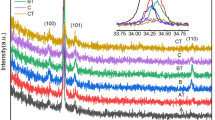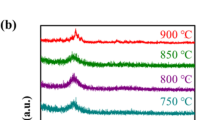The influence of laser pulses on the structure and electrophysical properties of resistive thick films based on the Sn0.9Sb0.1O2 solid solution is studied. Scanning electron microscopy, atomic force microscopy, and X-ray diffraction are used to examine the structure of resistive thick films and determine the distribution of Sn0.9Sb0.1O2 solid solution in surface layers and across the film. Exposure of thick resistive films to nano- and microsecond laser pulses changes their currentvoltage characteristics compared to samples subjected to millisecond pulses. The current-voltage characteristics become practically linear in the range from 1 to 10–11 V, thus allowing one to determine the optimum (α = 1) operating voltage range for resistors. The temperature coefficient of resistance depends on the length and energy of pulses.













Similar content being viewed by others
References
S. I. Rembeza, T. V. Svistova, E. S. Rembeza, et al., “Microstructure and physical properties of thin SnO2 films, Fiz. Tekh. Polyprov., 35, Issue 7, 796–799 (2001).
S. A. Kuznetsova, L. F. Ikonnikova, and V. V. Kozik, “Gas sensitive properties of antimony-doped SnO2,” Neorg. Mater., 43, No. 6, 706–711 (2007).
G. Eranna, B. C. Joshi, D. P. Runthala, et al., “Oxide materials for development of integrated gas sensors—A comprehensive review,” Crit. Rev. Solid State Mater. Sci., 29, Issue 3–4, 111–188 (2004).
T. A. Miller, S. D. Bakrania, C. Perez, et al., “Nanostructured tin dioxide materials for gas sensor application,” in: K. E. Geckeler and E. Rosenberg (eds.), Functional Nanomaterials, Am. Sci. Publishers, Valencia, USA (2006), p. 515.
T. Becker, S. Ahlers, C. Bosch-von Braunmuhl, et al., “Gas sensing properties of thin- and thick-film tin–oxide materials,” Sens. Actuators B, 77, Issue 1–2, 55–61 (2001).
Z. L. Xiao, C. Jie, L. S. Ling, et al., “Preparation and properties of Gd and Sb doped SnO2 conductive nanoparticles,” Adv. Mater. Res., 528, 50–53 (2012).
G. Xu, S. M. Xu, J. Ren, et al., “Synthesis and structure of nanocrystalline rare earth–doped SnO2,” Sens. Lett., 6, No. 6, 1028–1032 (2008).
O. A. Shilov and V. V. Shilov, “Nanocomposite oxide and hybrid organic and inorganic materials produced by sol–gel method. Synthesis. Properties. Applications,” in: Nanosystems, Nanomaterials, Nanotechnologies (Collected Scientific Papers) [in Russian], Akademperiodika, Kiev (2004), Issue 1, No. 1, pp. 9–83.
D. E. Dyshel’, S. A. Bliznyuk, B. M. Rud’, et al., “Synthesis and grain-size composition of antimony-doped tin dioxide powders for thick-film resistors,” in: Materials and New Processes in Microelectronics (Collected Scientific Papers) [in Russian], Inst. Probl. Materialoved. AN USSR, Kiev (1989), pp. 121–126.
B. M. Rud’ and I. M. Vinnitskii, “Effect of structural factors on the electrical properties of thick-film resistors,” in: New Materials for Thick-Film Technology in Microelectronics (Collected Scientific Papers) [in Russian], Inst. Probl. Materialoved. AN USSR, Kiev (1991), pp. 8–14.
A. V. Paustovskii, B. M. Rud’, V. E. Shelud’ko, et al., “Tensosensitivity of thick resistive BaB6 and SnO2–Sb films after laser radiation,” Fiz. Khim. Mekh. Mater., No. 4, 95–100 (2006).
B. M. Rud’, A. G. Gonchar, and E. Ya. Tel’nikov, “Tensoresistive effect in thick films based on antimonydoped tin dioxide,” Sens. Electr. Microsyst. Technol., No. 1, 72–79 (2005).
D. E. Dyshel’, Electrophysical Properties of Thick Resistive Films Based on Doped Tin Dioxide [in Russian], Author’s Abstract of PhD Thesis, Kiev (1986), p. 210.
V. A. Yanushkevich, “Criterion for forming shock waves under laser radiation of absorbing condensed media,” Fiz. Khim. Mekh. Mater., No. 5, 9–11 (1975).
G. N. Dul’nev, V. T. Parfenov, and A. V. Sigalov, Application of Computers for Solving Heat Exchange Problems [in Russian], Vysshaya Shkola, Moscow (1990), p. 207.
D. E. Dyshel’, B. M. Rud’, L. E. Pechentkovskaya, et al., “Application of modern physical and chemical analysis method for determining the composition of conducting phase of high-volume resistors,” in: New Materials in Microelectronics (Collected Scientific Papers) [in Russian], Inst. Probl. Materialoved. AN USSR, Kiev (1988), pp. 117–122.
D. E. Dyshel’, “Spectroscopic analysis of tin dioxide powders for thick-film semiconducting sensors,” in: Application of Conventional Film Materials and Development of New Ones (Collected Scientific Papers) [in Russian], Inst. Probl. Materialoved. NAN Ukrainy, Kiev (1994), pp. 97–100.
S. V. Svechnikov, P. S. Smertenko, A. V. Smirnov, et al., “Differential method for analyzing integral characteristics,” Ukr. Fiz. Zh., 43, No. 3, 374–377 (1998).
Acknowledgements
The research has been financed from Grant F54.2/013 of the State Fundamental Research Fund of Ukraine.
Author information
Authors and Affiliations
Corresponding author
Rights and permissions
About this article
Cite this article
Shelud’ko, V.E., Paustovskii, A.V., Rud’, B.M. et al. The Surface Morphology and Electrophysical Properties of Thick SnO2–Sb Films After Laser Processing. Powder Metall Met Ceram 53, 583–594 (2015). https://doi.org/10.1007/s11106-015-9653-3
Received:
Published:
Issue Date:
DOI: https://doi.org/10.1007/s11106-015-9653-3




